Japanese American Basketball Leagues

|
||
| Licensing | ||
Japanese American Basketball Leagues have been a part of the Japanese-American (JA) community for generations. Today, they play an integral role in the JA experience of young Japanese Americans. The reason JA basketball leagues are important is because they serve as a very tangible connection to the JA community. This album explores JA basketball leagues from three different areas with a Japantown: San Francisco, San Jose, and Los Angeles. I discovered that the evolution of the J-Leagues mirror that of the Japanese-American community.
Japantowns have changed since the pre-war, and immediately post-war era. Where J-Town used to be a one-stop shop for Japanese goods and services, but this too is no longer necessary. There is no longer a pressing need to live and be in the community. For many busy families, they would hardly ever be in Japantown if not for a community service off such as J-League, (Japanese) boy scouts, or Buddhist church, etc.
Another aspect of the Japanese American community that has changed is the face of the Japanese-American. The community is no longer defined by people of strictly Japanese descent. It is not as clear cut as it was for the Nisei and (for the most part) the Sansei. As a result of intermarriage with other ethnicities, many self-identified Japanese-Americans are now of mixed heritage.
The Japanese community will have to grapple with idea of defining a Japanese American, a question that bleeds even into J-Leagues. If J-Leagues were formed to give Japanese-Americans a chance to play but many Yonsei and Gosei are of mixed heritage, what criteria should be used to decide who is allowed to play?
Slides in this album |
|
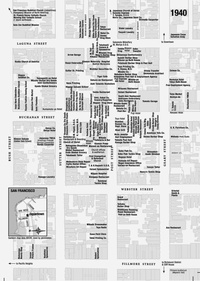
|
Map of SF Japantown Pre-WW IIHere is a map of San Francisco's Japantown before World War 2 saw Japanese-American residents relocated to internment camps. Japanese American basketball leagues (J-Leagues) started up with an institution in the community sponsoring them.
Map of Japantown 1940s |

|
J-League around the 1920's.A Nisei J-League team picture. The purpose of J-Leagues and the role of the Japanese community was clearly defined for the Nisei. "Playing sports to stay involved with the community is something my father and mother thought was important. If you were a Nisei, you didn’t associate with other …
Basketball Team around the 1920's. |

|
SF Drakes in 1969The need for J-Leagues persisted through the 3rd generation, Sansei. “They were no other places for them to play at the time…Size differential, because of segregation; they really had nowhere else to play.” – Robert Koga (pictured)
SF Drakes in 1969 |
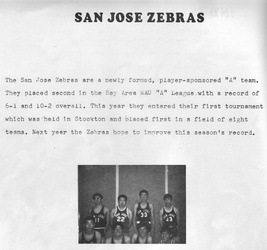
|
San Jose's Zebras in 1969The San Jose Zebras are pictured here in the NAU booklet from 1969. At this point in time, nearly all players listed in the booklet are Japanese-American.
NAU Zebras |

|
Map of SF Japantown After RedevelopmentThe purpose and role of the the J-Leagues were pretty clear-cut up until redevelopment came in (1970) and evicted many JA families. "Most of these kids didn’t have the size or speed or whatever to play in their high school. If the kid was going to stay active in …
Map of Japantown 1970 |
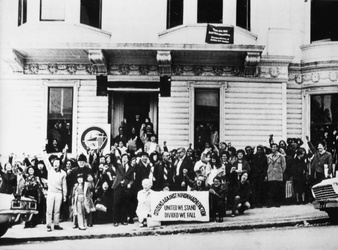
|
Citizens Against Nihonmachi Eviction Protest"Things have changed quite a bit as far as the JA community goes. I grew up in the Western Addition. Redevelopment came in and wanted to make it more commercial. A lot of the Japanese Americans had to move out. They migrated outside the city and all over the place. …
Protesting the Eviction |
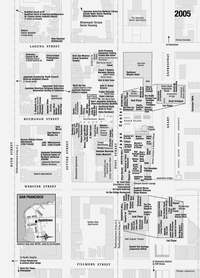
|
SF Japantown in 2005As the need to live in Japantown decreases, the need for a way to stay tied to the community increases. When Japanese Americans move out of Japantown, the function of the J-Leagues evolves from being an offshoot of the community to being a way to stay involved in it. …
Map of Japantown 2005 |

|
2004 NAU BookletNisei Athletic Union booklet 35 years later with teams from San Jose and Los Angeles. These fourth generation Japanese-Americans still see a need for the J-Leagues. "There’s a huge size disadvantage on our part." - Eric Kobuchi, former Taisho player.
2004 NAU Booklet |
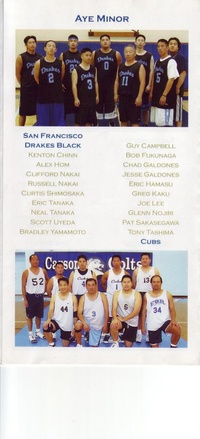
|
SF Drakes 2004The San Francisco Drakes 35 years later. When I asked some of these players why they didn't play for their respective high school teams, the general reply was, "It wasn't my choice. I was cut."
SF Drakes 2004 |
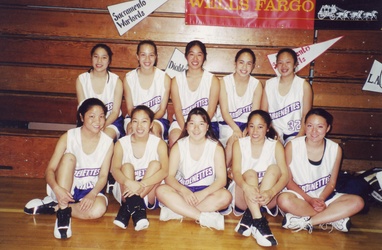
|
Ardenettes in 2000: A mix of different ethnicities.9 of the 10 players in this J-League are part Japanese, but only 2 of the 10 players are full Japanese. "The criteria to play was you had to be at least half Japanese and could carry 3 full Chinese on the team. Now, because of mixed marriage, they …
ardenettes |

|
Lew, Donahoe, AbantaoJ-Leagues serve as a way in which these three part Japanese-Americans to connect with the community and other Japanese Americans. All three individuals identify as Japanese-Americans even though they are of mixed heritage. In fact, Erin Donahoe (middle) and Darryl Abantao (right) are cousins through their Japanese side of …
Lew Donahoe Abantao |
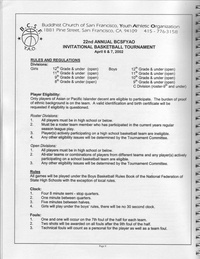
|
EligibilityThis page spells out the eligibility requirements or guidelines for playing in this specific J-League tournament. Japantown was a place for the Japanese community to live in relative insulation. In its current state, it faces issues of cultural preservation. J-Leagues reflect these changes in the community; it was formed …
Eligiblity |
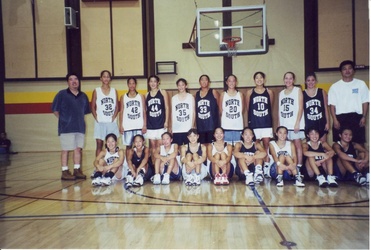
|
A North South Team PictureHere is a team picture from a North South Game (All-Stars from Northern California vs. Southern California J-League teams) Not only do they get to interact with Japanese Americans in their community, but players get to meet players from Southern California JA communities as well. "We get exposure to …
North South Teams |
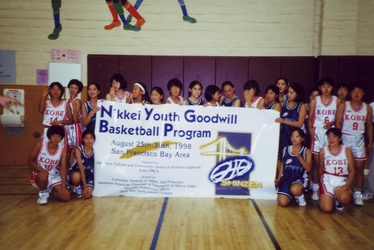
|
Shinzen ParticipantsHere is a picture of the Shinzen Goodwill Sister-City Exchange between San Francisco and Osaka. A group from the J-Leagues went to Japan and stayed with a Japanese family for 10 days through the Shinzen program. Programs like these help the younger generations gain exposure to their culture. …
Shinzen Participants |

|
Omiyage at Shinzen TournamentWhat the boys are doing here is "omiyage", the exchanging of gifts with the team from Japan. On the reason he was put in J-League: "I live outside the city so I'm not around Asian influences much. I'm not around a lot of Asian kids, so my dad did …
Omiyage |
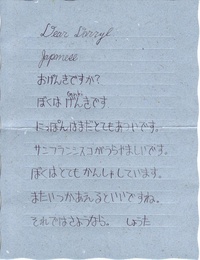
|
Letter from HomestayHere is a letter received by one of the first participants in the Shinzen program. They became penpals after the program.
Letter from Homestay |
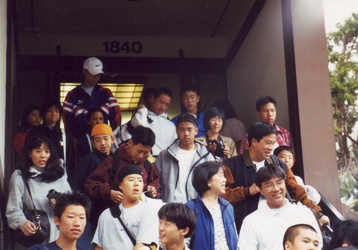
|
Parent InvolvementParents and Kids Spilling out of the JCCCNC after a tournament. Since many Japanese American families have moved out of Japantown, J-League is one of the few things that still tie them to the community.
Parent Involvement |
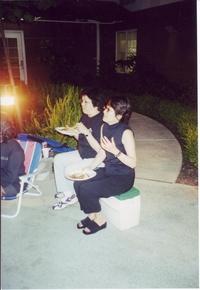
|
Women in the communityJ-Leagues not only encourage bonding with both the younger generations, but among the parents as well. "You have very few Japanese that live in Japantown. So, what else brings the community together? Basketball’s huge, even moreso in LA.”
Women in the community |
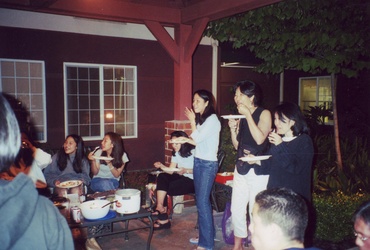
|
Parents and KidsArdenettes and their mothers at a tournament away from home. J-League is an activity for JA families, not just the individual player.
Parents and Kids |
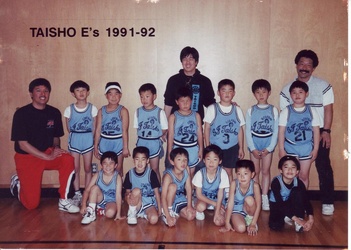
|
A Taisho Team in 1992 (E Team)Group of boys just starting out in a Japanese American basketball league based in San Francisco. "J-League basketball still gives you a sense of community. Evidently, this is true. If you …
A Taisho Team in 1992 (E Team) |
 hljleagues
hljleagues
 Japanese American Basketball Leagues
Japanese American Basketball Leagues
 Journal feed
Journal feed
